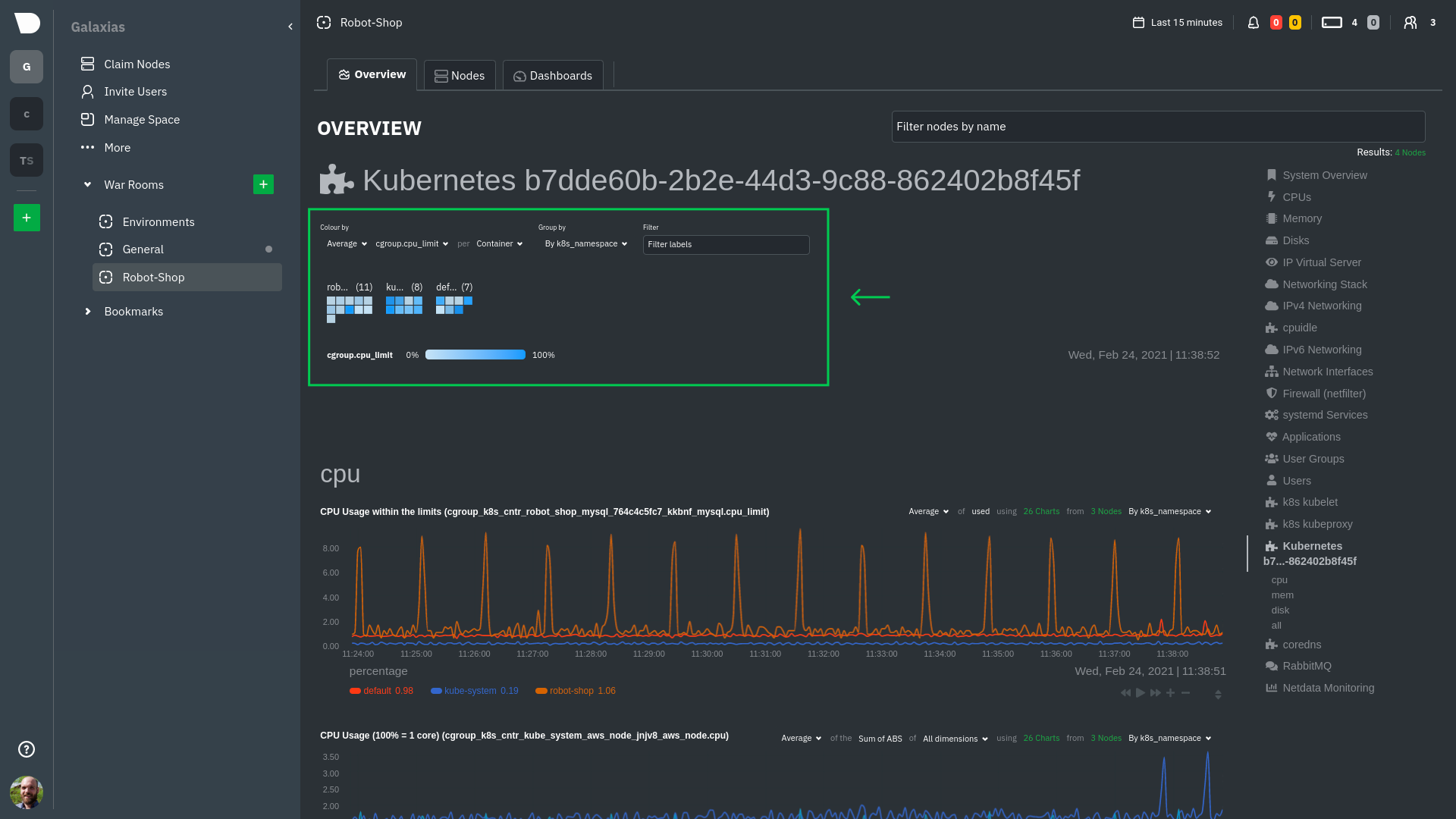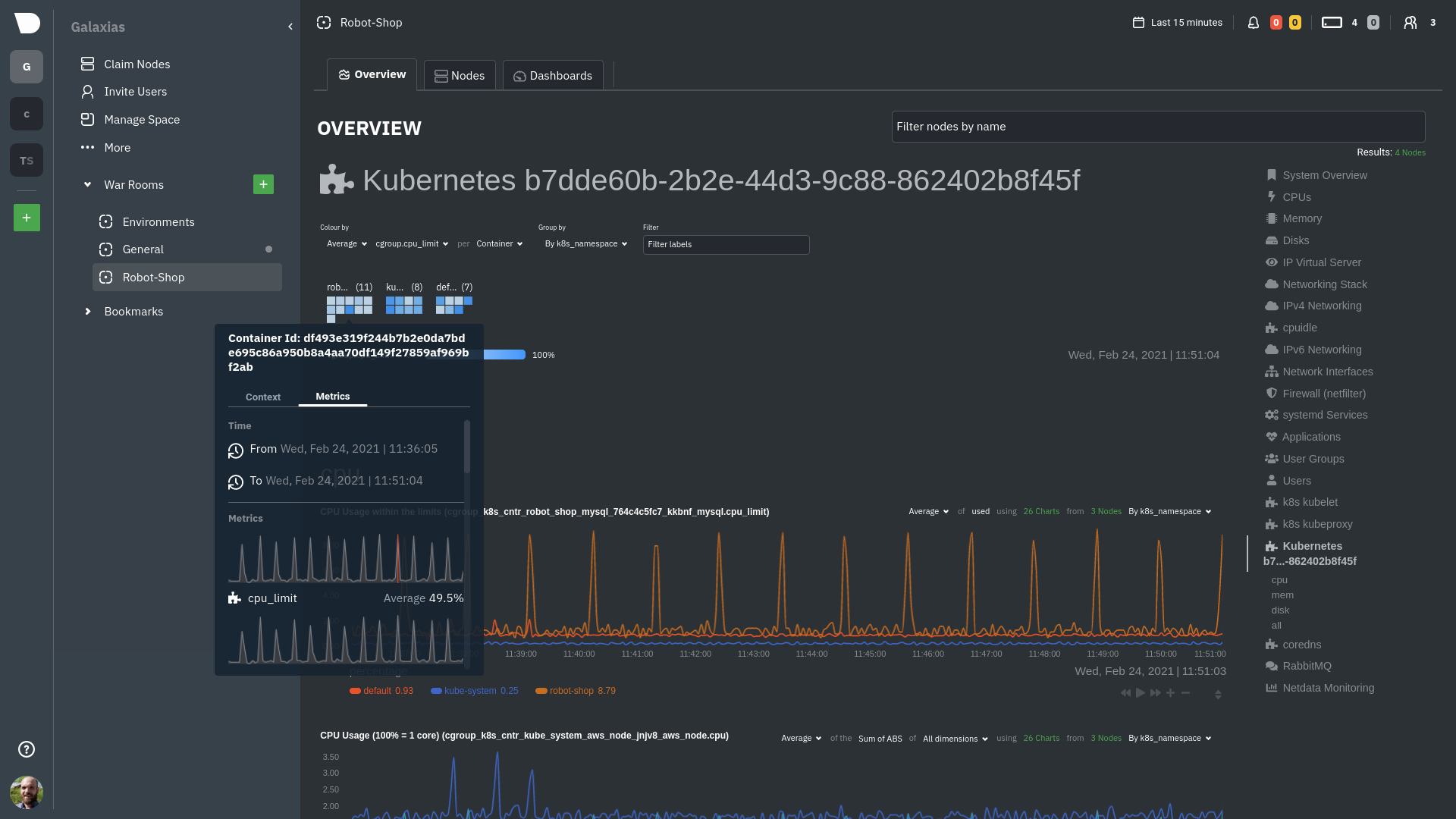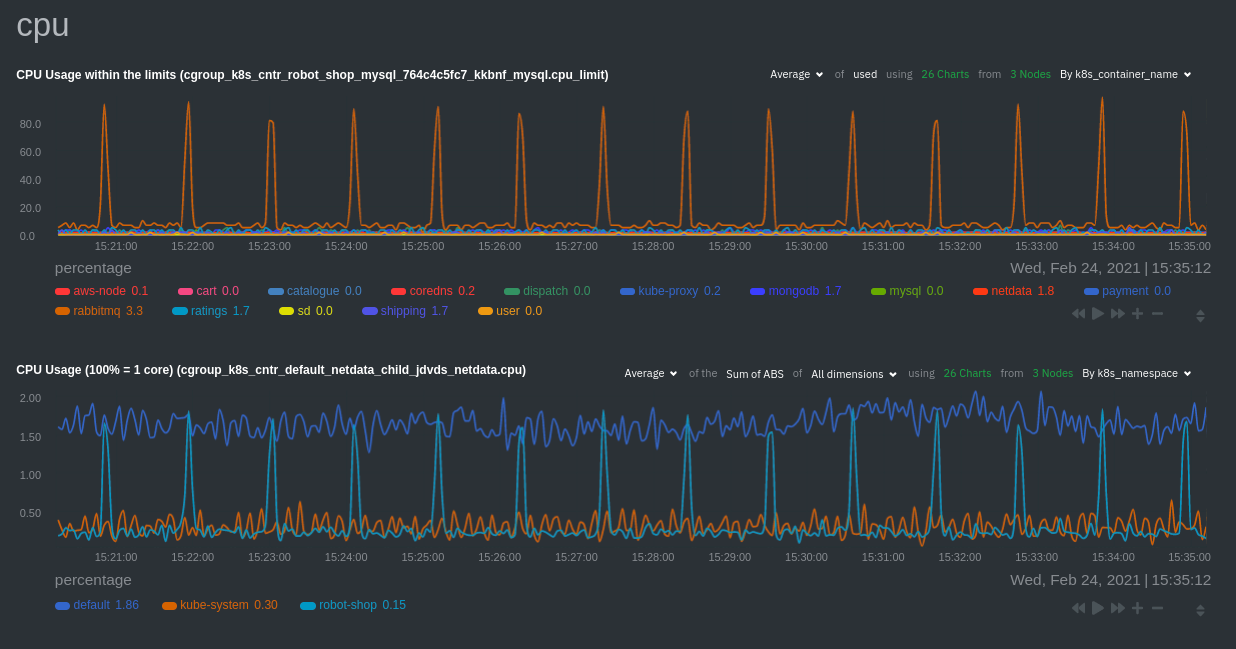| 123456789101112131415161718192021222324252627282930313233343536373839404142434445464748495051525354555657585960616263646566676869707172737475767778798081828384858687888990919293949596979899100101102103104105106107108109110111112113114115116117118119120121122123124125126127128129130131132133134135136137138139140141142143144145146147148149150151152153154155156157158159160161162163164165166167168169170171172173174175176177178179180181182183184185186187188189190191192193194195196197198199200201202203204205206207208209210211212213214215216217218219220221222223224225226227228229230231232233234 |
- # Kubernetes monitoring with Netdata
- This document gives an overview of what visualizations Netdata provides on Kubernetes deployments.
- At Netdata, we've built Kubernetes monitoring tools that add visibility without complexity while also helping you
- actively troubleshoot anomalies or outages. This guide walks you through each of the visualizations and offers best
- practices on how to use them to start Kubernetes monitoring in a matter of minutes, not hours or days.
- Netdata's Kubernetes monitoring solution uses a handful of [complementary tools and
- collectors](#related-reference-documentation) for peeling back the many complex layers of a Kubernetes cluster,
- _entirely for free_. These methods work together to give you every metric you need to troubleshoot performance or
- availability issues across your Kubernetes infrastructure.
- ## Challenge
- While Kubernetes (k8s) might simplify the way you deploy, scale, and load-balance your applications, not all clusters
- come with "batteries included" when it comes to monitoring. Doubly so for a monitoring stack that helps you actively
- troubleshoot issues with your cluster.
- Some k8s providers, like GKE (Google Kubernetes Engine), do deploy clusters bundled with monitoring capabilities, such
- as Google Stackdriver Monitoring. However, these pre-configured solutions might not offer the depth of metrics,
- customization, or integration with your preferred alerting methods.
- Without this visibility, it's like you built an entire house and _then_ smashed your way through the finished walls to
- add windows.
- ## Solution
- In this tutorial, you'll learn how to navigate Netdata's Kubernetes monitoring features, using
- [robot-shop](https://github.com/instana/robot-shop) as an example deployment. Deploying robot-shop is purely optional.
- You can also follow along with your own Kubernetes deployment if you choose. While the metrics might be different, the
- navigation and best practices are the same for every cluster.
- ## What you need to get started
- To follow this tutorial, you need:
- - A free Netdata Cloud account. [Sign up](https://app.netdata.cloud/sign-up?cloudRoute=/spaces) if you don't have one
- already.
- - A working cluster running Kubernetes v1.9 or newer, with a Netdata deployment and connected parent/child nodes. See
- our [Kubernetes deployment process](/packaging/installer/methods/kubernetes.md) for details on deployment and
- connecting to Cloud.
- - The [`kubectl`](https://kubernetes.io/docs/reference/kubectl/overview/) command line tool, within [one minor version
- difference](https://kubernetes.io/docs/tasks/tools/install-kubectl/#before-you-begin) of your cluster, on an
- administrative system.
- - The [Helm package manager](https://helm.sh/) v3.0.0 or newer on the same administrative system.
- ### Install the `robot-shop` demo (optional)
- Begin by downloading the robot-shop code and using `helm` to create a new deployment.
- ```bash
- git clone git@github.com:instana/robot-shop.git
- cd robot-shop/K8s/helm
- kubectl create ns robot-shop
- helm install robot-shop --namespace robot-shop .
- ```
- Running `kubectl get pods` shows both the Netdata and robot-shop deployments.
- ```bash
- kubectl get pods --all-namespaces
- NAMESPACE NAME READY STATUS RESTARTS AGE
- default netdata-child-29f9c 2/2 Running 0 10m
- default netdata-child-8xphf 2/2 Running 0 10m
- default netdata-child-jdvds 2/2 Running 0 11m
- default netdata-parent-554c755b7d-qzrx4 1/1 Running 0 11m
- kube-system aws-node-jnjv8 1/1 Running 0 17m
- kube-system aws-node-svzdb 1/1 Running 0 17m
- kube-system aws-node-ts6n2 1/1 Running 0 17m
- kube-system coredns-559b5db75d-f58hp 1/1 Running 0 22h
- kube-system coredns-559b5db75d-tkzj2 1/1 Running 0 22h
- kube-system kube-proxy-9p9cd 1/1 Running 0 17m
- kube-system kube-proxy-lt9ss 1/1 Running 0 17m
- kube-system kube-proxy-n75t9 1/1 Running 0 17m
- robot-shop cart-b4bbc8fff-t57js 1/1 Running 0 14m
- robot-shop catalogue-8b5f66c98-mr85z 1/1 Running 0 14m
- robot-shop dispatch-67d955c7d8-lnr44 1/1 Running 0 14m
- robot-shop mongodb-7f65d86c-dsslc 1/1 Running 0 14m
- robot-shop mysql-764c4c5fc7-kkbnf 1/1 Running 0 14m
- robot-shop payment-67c87cb7d-5krxv 1/1 Running 0 14m
- robot-shop rabbitmq-5bb66bb6c9-6xr5b 1/1 Running 0 14m
- robot-shop ratings-94fd9c75b-42wvh 1/1 Running 0 14m
- robot-shop redis-0 0/1 Pending 0 14m
- robot-shop shipping-7d69cb88b-w7hpj 1/1 Running 0 14m
- robot-shop user-79c445b44b-hwnm9 1/1 Running 0 14m
- robot-shop web-8bb887476-lkcjx 1/1 Running 0 14m
- ```
- ## Explore Netdata's Kubernetes monitoring charts
- The Netdata Helm chart deploys and enables everything you need for monitoring Kubernetes on every layer. Once you deploy
- Netdata and connect your cluster's nodes, you're ready to check out the visualizations **with zero configuration**.
- To get started, [sign in](https://app.netdata.cloud/sign-in?cloudRoute=/spaces) to your Netdata Cloud account. Head over
- to the Room you connected your cluster to, if not **General**.
- Let's walk through monitoring each layer of a Kubernetes cluster using the Overview as our framework.
- ## Cluster and node metrics
- The gauges and time-series charts you see right away in the Overview show aggregated metrics from every node in your
- cluster.
- For example, the `apps.cpu` chart (in the **Applications** menu item), visualizes the CPU utilization of various
- applications/services running on each of the nodes in your cluster. The **X Nodes** dropdown shows which nodes
- contribute to the chart and links to jump a single-node dashboard for further investigation.
- 
- For example, the chart above shows a spike in the CPU utilization from `rabbitmq` every minute or so, along with a
- baseline CPU utilization of 10-15% across the cluster.
- ## Pod and container metrics
- Click on the **Kubernetes xxxxxxx...** section to jump down to Netdata Cloud's unique Kubernetes visualizations for view
- real-time resource utilization metrics from your Kubernetes pods and containers.
- 
- ### Health map
- The first visualization is the [health map](/docs/dashboards-and-charts/kubernetes-tab.md#health-map),
- which places each container into its own box, then varies the intensity of their color to visualize the resource
- utilization. By default, the health map shows the **average CPU utilization as a percentage of the configured limit**
- for every container in your cluster.
- 
- Let's explore the most colorful box by hovering over it.
- 
- The **Context** tab shows `rabbitmq-5bb66bb6c9-6xr5b` as the container's image name, which means this container is
- running a [RabbitMQ](/src/go/plugin/go.d/collector/rabbitmq/README.md) workload.
- Click the **Metrics** tab to see real-time metrics from that container. Unsurprisingly, it shows a spike in CPU
- utilization at regular intervals.
- 
- ### Time-series charts
- Beneath the health map is a variety of time-series charts that help you visualize resource utilization over time, which
- is useful for targeted troubleshooting.
- The default is to display metrics grouped by the `k8s_namespace` label, which shows resource utilization based on your
- different namespaces.
- 
- Each composite chart has a [definition bar](/docs/dashboards-and-charts/netdata-charts.md#definition-bar)
- for complete customization. For example, grouping the top chart by `k8s_container_name` reveals new information.
- 
- ## Service metrics
- Netdata has a [service discovery plugin](https://github.com/netdata/agent-service-discovery), which discovers and
- creates configuration files for [compatible
- services](https://github.com/netdata/helmchart#service-discovery-and-supported-services) and any endpoints covered by
- our [generic Prometheus collector](/src/go/plugin/go.d/collector/prometheus/README.md).
- Netdata uses these files to collect metrics from any compatible application as they run _inside_ of a pod. Service
- discovery happens without manual intervention as pods are created, destroyed, or moved between nodes.
- Service metrics show up on the Overview as well, beneath the **Kubernetes** section, and are labeled according to the
- service in question. For example, the **RabbitMQ** section has numerous charts from the [`rabbitmq`
- collector](/src/go/plugin/go.d/collector/rabbitmq/README.md):
- 
- > The robot-shop cluster has more supported services, such as MySQL, which are not visible with zero configuration. This
- > is usually because of services running on non-default ports, using non-default names, or required passwords. Read up
- > on [configuring service discovery](/packaging/installer/methods/kubernetes.md#configure-service-discovery) to collect
- > more service metrics.
- Service metrics are essential to infrastructure monitoring, as they're the best indicator of the end-user experience,
- and key signals for troubleshooting anomalies or issues.
- ## Kubernetes components
- Netdata also automatically collects metrics from two essential Kubernetes processes.
- ### kubelet
- The **k8s kubelet** section visualizes metrics from the Kubernetes agent responsible for managing every pod on a given
- node. This also happens without any configuration thanks to the [kubelet
- collector](/src/go/plugin/go.d/collector/k8s_kubelet/README.md).
- Monitoring each node's kubelet can be invaluable when diagnosing issues with your Kubernetes cluster. For example, you
- can see if the number of running containers/pods has dropped, which could signal a fault or crash in a particular
- Kubernetes service or deployment (see `kubectl get services` or `kubectl get deployments` for more details). If the
- number of pods increases, it may be because of something more benign, like another team member scaling up a
- service with `kubectl scale`.
- You can also view charts for the Kubelet API server, the volume of runtime/Docker operations by type,
- configuration-related errors, and the actual vs. desired numbers of volumes, plus a lot more.
- ### kube-proxy
- The **k8s kube-proxy** section displays metrics about the network proxy that runs on each node in your Kubernetes
- cluster. kube-proxy lets pods communicate with each other and accept sessions from outside your cluster. Its metrics are
- collected by the [kube-proxy
- collector](/src/go/plugin/go.d/collector/k8s_kubeproxy/README.md).
- With Netdata, you can monitor how often your k8s proxies are syncing proxy rules between nodes. Dramatic changes in
- these figures could indicate an anomaly in your cluster that's worthy of further investigation.
- ## What's next?
- After reading this guide, you should now be able to monitor any Kubernetes cluster with Netdata, including nodes, pods,
- containers, services, and more.
- With the health map, time-series charts, and the ability to drill down into individual nodes, you can see hundreds of
- per-second metrics with zero configuration and less time remembering all the `kubectl` options. Netdata moves with your
- cluster, automatically picking up new nodes or services as your infrastructure scales. And it's entirely free for
- clusters of all sizes.
- ### Related reference documentation
- - [Netdata Helm chart](https://github.com/netdata/helmchart)
- - [Netdata service discovery](https://github.com/netdata/agent-service-discovery)
- - [Netdata Agent · `kubelet`
- collector](/src/go/plugin/go.d/collector/k8s_kubelet/README.md)
- - [Netdata Agent · `kube-proxy`
- collector](/src/go/plugin/go.d/collector/k8s_kubeproxy/README.md)
- - [Netdata Agent · `cgroups.plugin`](/src/collectors/cgroups.plugin/README.md)
|